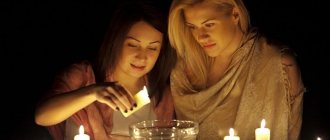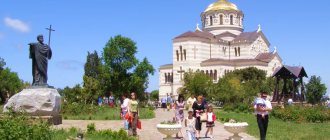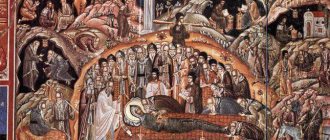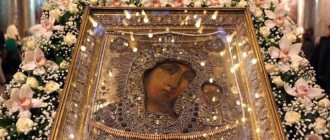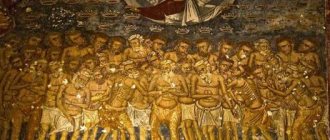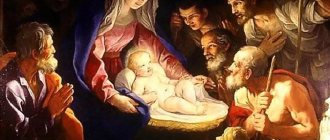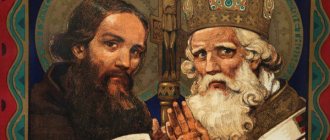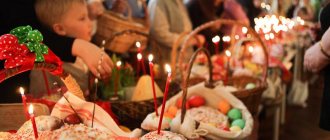Prince Vladimir: from pagan reform to the Baptism of Rus'
Prince Vladimir the Great ruled in Kyiv from 979 to 1105. He was the son of the Kyiv prince Svyatoslav Igorevich and his concubine Malusha (according to legend, the daughter of the Drevlyan prince Mal). Prince Vladimir's grandmother was Princess Olga, who converted to Christianity back in 957.
Vladimir himself was originally a pagan. According to the Tale of Bygone Years, he ascended the princely throne in Kyiv in 980. His first attempts to overthrow polytheism in Rus' came down to reducing the number of gods. of the 6 main gods of Slavic paganism was built on Starokievskaya Mountain . However, monotheism in its various forms (Christianity, Islam, was already spreading throughout the territory of Kievan Rus. The prince was faced with the question of choosing a faith. After much deliberation, he chose the Orthodox faith, following the example of Byzantium.
“Grand Duke Vladimir chooses religion”, canvas by I. E. Eggink
Popular writings
The famous Russian and Soviet writer Maxim Gorky had incomparable talent, starting to write in the style of romance and ending in the style of drama. At the end of his career, he began to especially pay
Nikolai Vasilyevich Gogol’s comedy “The Inspector General” presents images of bureaucratic officials of a small county town. The author ironically ridicules the vices of officials who literally
What is determination? This is a quality of a person that is characterized by the ability to set goals, draw up a plan for achieving them and implementing them.
Source
A Brief History of the Baptism of Rus'
Vladimir Svyatoslavovich was baptized in Korsun (Khersones, the current territory of Sevastopol) at the request of the Byzantine emperors Vasily II and Constantine VIII. The day before, he captured Korsun with the demand that the sister of the Byzantine emperors, Anna, be given in marriage to him. The monarchs agreed on the condition that the Prince of Kiev himself accept Christianity.
Baptism of Saint Prince Vladimir (fresco by V. M. Vasnetsov in the Vladimir Cathedral in Kyiv, 1890)
Prince Vladimir the Great was baptized and received a new name Vasily, in honor of the same Constantinople Emperor Vasily II. He married Anna and released all his concubines, of which Vladimir had many. After returning to Kyiv, Prince Vladimir began to establish Christianity in Rus'.
The pagan temple was destroyed, and the statues of the gods were overthrown. According to the chronicle, the statue of Perun was tied to the tail of a horse and dragged around Kyiv, beating with sticks. The prince himself sent out people who announced the baptism of all residents of Kyiv in the waters of the Dnieper. Taking advantage of his authority, Prince Vladimir and the Korsun priests freely baptized the people of Kiev in 988. This happened in the place where the waters of the Pochayna River flow into the Dnieper.
In other Slavic lands, paganism “was getting used to” for several centuries after Epiphany. In some lands (Rostov, Novgorod, Murom), pagan riots and uprisings occurred every now and then, which were brutally suppressed.
Vasily Surikov, paintings of the Cathedral of Christ the Savior
Vasily Surikov. Self-portrait. 1915. State Russian Museum
Vasily Surikov. Fourth Ecumenical Council of Chalcedon. 1876. State Russian Museum
When young Surikov received a prestigious order to decorate the Cathedral of Christ the Savior, historians and researchers already knew much more about Byzantium. The artist was commissioned to paint the first four Ecumenical Councils, which took place in the 3rd–4th centuries in Nicaea, Constantinople, Ephesus and Chalcedon. The paintings themselves were lost during the demolition of the temple, but Surikov’s sketches were preserved.
The artist did not copy the vestments of Orthodox priests in his work. The priests' draperies flowed, reminiscent of Roman togas, but such details of their vestments as miters and omophorions brought their appearance closer to the canonical image of the holy fathers on Byzantine icons. Surikov carefully studied Byzantine architecture, so he depicted the interiors on the frescoes very accurately, as well as the imperial crowns and thrones, which he carefully copied from ancient coins and reliefs.
True, the completed paintings differed significantly from the sketches. For example, at first Surikov depicted bishops with long beards, in an “oriental” style, but at his insistence he rewrote their faces, making their beards short, “European”. The customers also did not like the overly expressive style of the sketches, and as a result, “Cathedrals” turned out to be quite academic and restrained. Surikov wrote to his family that he did not intend to argue with this decision - he wanted to quickly complete the work on the state order and receive a fee.
Day of the Baptism of Rus' July 28 - establishing a memorable date
The Day of the Baptism of Rus' on July 28 was first officially celebrated in 1888. In 1988, due to the “scientific atheism” of the Soviet party, the celebration of the 1000th anniversary of the Baptism of Rus' was not pompous. However, several scientific and public events dedicated to this event still took place. In 2010, the Day of the Baptism of Rus' was included in the list of state memorial dates. Throughout the country on this day, services are held according to the rules of the holiday. And exactly at noon, bells can be heard from the temples.
How is the Epiphany of Kievan Rus celebrated in 2020?
In 2021, due to the coronavirus pandemic, the format of celebrations in honor of the adoption of the Christian faith has been slightly changed. Prayer services in churches will be held in compliance with quarantine restrictions, and the religious procession in Kyiv in honor of the Baptism of Rus' in 2020 will not take place at all.
Composition based on Vasnetsov’s painting “The Baptism of Prince Vladimir”
Among Vasnetsov’s works devoted to a religious theme, I would like to note the painting “The Baptism of Prince Vladimir.” Before painting this painting, the author spent a lot of time studying the manuscripts and works of the chronicler Nestor. Thanks to this, the painting has great historical value, but it is not like painting icons, despite this theme. It is known that the painting is based on the legend of “The Tale of Bygone Years.”
In the center of the picture is Prince Vladimir. He sits in a font decorated with a cross. Here the prince is depicted with the same facial features as in the painting “The Baptism of Rus'”. He is shown as he was in ordinary life. It is not for nothing that the artist studied a lot of sources, before before starting work. He has a brown beard and hair of the same color. They are loose. The artist depicted Vladimir’s face with a regular oval shape, his eyes are very concentrated, and his eyebrows are frowned. The whole image speaks of the importance of the decision made, which became fateful for the entire state .The courtiers standing nearby hold his luxurious robe embroidered with gold. Only this speaks of his noble, royal origin. This event is very large-scale, the picture shows priests who are located to the left of the prince. His army is depicted on the right. A dome rises above them a temple or church with very beautiful paintings and frescoes. This topic was very close to the artist, so he tried to show everything in his works down to the smallest detail, so as not to distort the story. Light pours from the windows located above.
In general, I think that this picture is quite light; the artist used many white shades to emphasize the pure thoughts and importance of the event. I especially want to note that the artist showed the different attitudes of all these classes to what was happening. The priests perform their duties, the nobility obediently looks at the ruler , favorably accepting his decision.
Composition based on Vasnetsov’s painting “The Baptism of Prince Vladimir”
goldsoch.info
The Baptism of Rus' in painting
Such an important event as the Baptism of Rus' was captured in paintings by famous artists.
For example, in 1890, the painter Viktor Mikhailovich Vasnetsov painted his famous painting The Baptism of Rus'. A similar fresco depicting Prince Vladimir is located in Kyiv in the Vladimir Cathedral.
Another famous work belongs to the brush of Fyodor Andreevich Bronnikov and is dated 1883.
And this is a painting by Andrei Ivanov from 1829.
The theme of the Baptism of Rus' also inspired such artists as Vasily Perov, Alexey Kivshenko, Klavdiy Lebedev and others.
Ilya Repin, “Nicholas of Myra saves three innocently convicted people from death”
Ilya Repin. Self-portrait. 1887. State Tretyakov Gallery
Ilya Repin. Nicholas of Myra spares three innocent prisoners from death. 1888. State Russian Museum
Initially, “St. Nicholas” was commissioned by Ilya Repin from one monastery, however, when Repin realized that instead of a religious picture he was creating a dramatic story, he decided to finish the picture for himself and write a new one for the customer.
Repin masterfully used the “Byzantine” material available to him. When creating the image of Nicholas the Wonderworker, Bishop of Myra in Lycia in the 4th century, the artist was guided by ancient icons, where he was depicted as a thin, bald old man with sunken eyes and a short beard.
Repin's work was replete with historically accurate details: for example, the carefully painted tunic of a condemned man, the standard of a legion in the crowd - which gave it a special realism.
It is noteworthy that the sitters for Repin’s canvas were famous cultural figures of that time. The artist partially copied the saint himself from the poet Apollo Maykov; executioner - from the artist Nikolai Kuznetsov; The writer Hieronymus Yasinsky posed for the kneeling figure, and Dmitry Merezhkovsky posed for the young man in pink.

